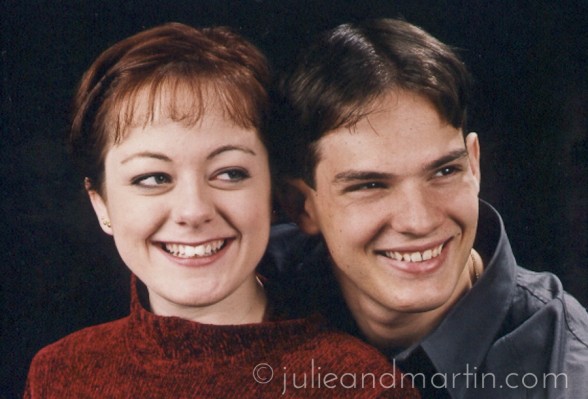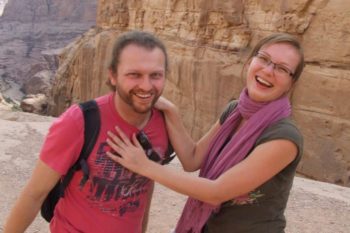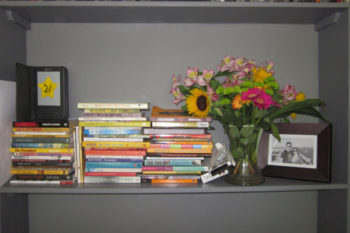Julie is from the USA and Martin is from Germany. They met when Julie was on exchange student in Germany back in 1999 – as their blog says: “It all started when an American girl met a German boy”. I really like how they answered the interview questions from each of their perspectives. So read on to know more about their family’s multicultural life in the USA.

Tell us a bit about yourself. How would your friends or family describe you?
Julie: We’re Julie and Martin Weckerlein, and we’ve been married ten years now.
Martin: I am a stay-at-home dad, and Julie works in downtown Washington DC as a federal employee. We’ve been writing a blog about our multicultural family since 2001. We actually met in 1999, when Julie was a foreign exchange student in Germany, and I was friends with her exchange partner.
Julie: Yes, I had just graduated from my Northern Kentucky high school, and was really excited to visit Europe for the first time. He was one of the first people I met.
Martin: We have three kids, two girls and a little boy. And a dog and two cats. It’s a little bit of a circus around our house.
Julie: I think if you asked our friends to describe us, they’d say we’re a very active and creative family. We’re always doing something as a family.
Where do you live? Where are you from? If those are different, can you tell us a little about what inspired your move?
Julie: We live in Northern Virginia, just outside of Washington D.C. I was born in Texas, but grew up in the Cincinnati metropolitan area.
Martin: I am from Erlangen, Germany, which is very close to Nuremberg.
Julie: I was active duty in the US Air Force for nine years, which caused us to move around every few years. First, we lived in Germany, then spent three years in Italy. My last active duty assignment was to the Pentagon, which brought us to this area. Even though the both of us aren’t from around here, we really fell in love with the area and decided to settle here.
Martin: We like to point out that it’s an eight-hour drive to Ohio, and an eight-hour flight to Germany. We’re right in the middle of our families.
If you would describe yourself as multi-cultural, tell us a bit about what culture you most identify with and why. What culture do your kids most associate with?
Martin: Even though I’ve been living in the United States for almost seven years, I still consider myself German.
Julie: It’s funny: Martin will sometimes do or saying something that just causes me to shake my head and say, “That is SO German!” There are just some qualities that are unique to that culture, and he’s got them.
Martin: People often tell me that I’m logical and organized. I like things to be in order. I don’t have a lot of patience for those who lack common sense. Sometimes, I get baffled by some of the rules and laws over here in America because I think some behavior should just be practical common sense.
Julie: And Martin really loves his German soccer teams.
Martin: I do. Whenever the games come on, I have to watch.
Julie: Though I feel homesick for Germany and Europe, where I lived for almost a total of six years, I am definitely American. I’m really proud of where I come from, and the opportunities I have in this country. I can be outspoken, and I’m pretty ambitious. I also think one of my American qualities is being so open and social with others right off the bat.
Martin: That was something that I noticed first with Julie when I met her in Germany. She acknowledged just about everyone we passed on the streets with either a greeting or a nod. Unless you know the person, that’s just not something people do in Germany and I had to tell her, “People know you are American when you do that.”
Julie: Martin and I were celebrating New Years Eve in Paris, France one year, and as the clock struck midnight, we were shouting out “Happy New Year” in every language we knew, and when I said it in English, a group of people walking behind us said, “Hey, that’s an American like us!” So we started talking, identifying where we were from, and along the way, other Americans started talking with us, too. It was a great moment. Right there, under the Eiffel tower, thousands of miles from the East Coast, were all these American strangers connecting and wishing each other well. It’s just what Americans do.
Martin: Just by the fact that our kids are growing up and going to school here in America, I’m sure they identify mostly as American, but we’re raising them to be proud German-Americans.
Can you describe a typical day for you?
Martin: As a stay-at-home dad, my day really starts when the kids wake up with the sun. We eat breakfast together, my oldest goes to school, we take Julie to the Metro subway station and I have the younger two with me as we do chores, run errands, or do something fun, like go to the park or playgroup.
Julie: I often wake up with the kids and help with the morning routine before I leave for my job in the city. It takes exactly one hour and 10 minutes to get to my office, and most of that is done via the Metro subway system. I really enjoy working downtown. My office isn’t far from the Capitol building and Washington monument, and I always have to stop and stare for a few seconds whenever I see them. I usually don’t get home from work until just before dinner.
Martin: We have a rule where we have to eat at least one meal together as a family. Sometimes, that’s breakfast, but most of the time, that’s dinner.
Julie: Now that it’s summer, we are outside in the evenings. Our favorite thing to do is go on a long bike-ride in the trails next to our neighborhood. Even though we’re close to the city, this area is full of parks and nature preserves, and it’s great to be outdoors.
Martin: It reminds me of the Volksmarches we do in Germany all the time.
What is the best part of living in the USA for you? The worst?
Martin: For me, there are a lot of great things about living in America. The cost of living is affordable, There are many employment and education opportunities here. For the day-to-day sort of thing, I like how Americans use coupons. We save so much money with them. I like the challenge and resourcefulness of buying household goods that way. They don’t have coupons in Germany, and things are so expensive over there.
Julie: I wish it was as easy and affordable to travel in America as it is in Europe. There are a lot of discount airlines over there and the rail system is amazing in Europe. When we lived over there, we traveled by train so often, and I loved that I could go in any direction for a few hours and be in a completely different country. It’s not so easy to get around in the states, and while each American state and region has its own personality and flavor, it’s just not the same as it is in Europe. I miss that. However, the population here in Washington DC is so diverse. We live ten minutes from an Afghan restaurant run by family friends from Kabul. Our oldest goes to elementary school with kids from all over the world. America really is a melting pot of cultures and languages.
What books or films would you recommend someone who’d like to know more about the USA / Germany?
Julie: “Metropolis” is one of the best movies ever and a classic example of the cultural and artist revolution that came out of the Weimar Republic in post-WWI Germany. It’s a silent science-fiction film, but its themes and style are still relevant today. You can still see references to the movie in other artists’ work today. It continues to inspire other films and genres. It’s one of my most favorites.
Martin: I remember seeing the American movie “E.T” when I was younger. Of course, it was dubbed in the German language, but I remember thinking it must really be neat to be an American boy with an alien living with you.
Julie: We also have this book called German Pride: 101 Reasons to be Proud You’re German, and it lists the various ways Germans contributed to American culture. Every year during our Family Fest, we read from it and talk about the ways we use or know of these things in our everyday life, such as using the Fahrenheit scale to measure temperature or driving along our highway system, which was first developed in Germany as the Autobahn.
What language or languages do you use on a day to day basis?
Martin: I speak German at home with the kids. They tend to answer in English, but they understand what I’m saying. And we have video chats with my family in Germany all the time, and my oldest daughter is now confident enough in her language abilities to call her aunt in Germany and just talk.
Julie: I learned German in high school, and now I’m able to speak it comfortably with my family. But for the most part, I speak English at home. Sometimes, if Martin and I want to talk about something without the kids knowing, we’ll speak in German, but now that our kids are older and really paying attention and understand, that no longer works.
Tell me about a national hero in your country. Who are they and what are they admired for?
Martin: My grandmother, Oma, isn’t a national hero, but she’s my personal German hero. She lived to be 99 years old over in Germany. She was a young child during War World I and a young mother during World War II, so she really experienced a lot and witnessed a lot of history. She spoke very candidly about some of the things she experienced, and it makes me appreciate everything she went through during those times. Her generation really struggled. I think most people would be angry or bitter about those things, but she was never like that. She was upbeat, and she enjoyed life and her family. When Julie and I were married, I remember Oma saying, “To think Germany and America fought two wars in my lifetime, and now we all sit together at a table as my grandson marries an American, and we are all happy.”
Julie: My oldest daughter is currently learning about American women who helped shape the country, and right now, she’s reading about Amelia Earhart. Amelia was the first woman to receive the US Distinguished Flying Cross, and she set aviation records and wrote books, went to school, and was such a great mentor to others. My daughter was born next to an Air Force base in Italy where F-16 fighter jets took off all the time, and she’s been around a lot of other aircraft thanks to my military career, so she’s always had a fascination with aviation. That Amelia, who was also German-American, was able to accomplish so much in a time where women weren’t expected to do so is really impressive. Amelia Earhart is really an American legend who still inspires others to this day.
Tell me about your favorite holiday, and what cultural traditions you practice to celebrate on that day.
Julie: We actually created a family holiday that we call “Family Fest.” October 6 is recognized as German-American Day here in America. I didn’t know about it until a few years ago, and that’s when I decided we were going to celebrate it in our home. We hang up both our German and American flags, and I prepare a traditional German meal with some American twists throughout, such as bratwurst and hotdogs. The U.S. President signs a proclamation every year, so we print it out and read it as a family. Then we talk about our ancestors. My great-great-grandfather actually came over from Germany and settled in Cincinnati, so I talk about his life story and how America changed his life. Martin also talks about his family history in Germany.
Martin: We also talk about famous German-Americans, people who called both countries home, people ranging from Albert Einstein to Heidi Klum. We also try to list all the things that Germans invented that Americans use all the time. Our kids are young, so they really get into it, and every year, we try to do something bigger and better with it. This year, we’re going to invite some of our friends to enjoy the day with us, too.
Describe a favorite typical meal from your country.
Martin: A typical breakfast in Germany is very simple: toast with either fruit spread or Nutella, maybe a soft-boiled egg or croissants with coffee or chocolate milk for the kids. I tend to still eat breakfast that way here in America.
Julie: Mine is not a national meal, but it’s a regional meal local to where I grew up: Cincinnati chili. It’s not a Tex-Mex type of chili. It’s more of a thin sauce, made out of minced meat and seasonings that can include allspice, cinnamon, or even chocolate. It’s usually served over hot dogs and topped with a mountain of shredded cheddar cheese: those are called cheese coneys. If it’s eaten over spaghetti noodles, it’s called a three-way. Cincinnati is really passionate about its chili: there’s a chili-fest every year dedicated to the dish. Those who grew up in the area love it. Outsiders either love it or hate it. I knew Martin was the man for me when he visited me in Cincinnati, and really loved it. I don’t think we could have married if he did not.

What’s something that visitors are often surprised by when getting to know your country/culture?
Martin: People who visit Germany are usually very surprised by how clean the streets and neighborhoods are over there. You won’t see trash in the gutters or anything. Before I lived in America, I didn’t think it was a big deal, but now I realize that Germans are really particular about litter.
Julie: I think foreigners don’t fully comprehend that ours is a very large country, and major cities and landmarks are spread out over a large distance. When Martin visited me in Cincinnati, he honestly thought Chicago was a short drive away, when it’s really five hours by car. It’s not like Europe, where everything is relatively close to each other. We have a lot to see here, but you need a really long vacation to see it all!
Julie and Martin’s blog about their multicultural family is called Julie and Martin.
Read more:
Children’s games from around the world
Are some cultures more kid-friendly than others?
5 tips for raising a bilingual child





it seems that you have huge reserve of information and enjoy great gift in writing am 49 years old a grand father i have seven kids of mine my wife is great lady i love my wife more than any thing i hope you will try to help me in knowing your culture because i worked with German ,american doctors in field researches nice to know you [abu yasser ]
i think writing about any thing has to do with the way you look at
any way your back ground as i see is clearly great so i think you must gain more about what you write that is my opinion